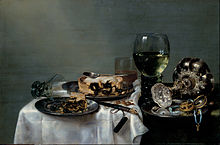
Back Berkemeyer German Berkemeyer ET Berkemeyer French Berkemeyer Dutch Беркемайер Russian Berkemeyer UZ
This article needs additional citations for verification. (July 2018) |

A Berkemeyer is a drinking glass with a wide, flared bowl, dating from 15th-century Germany and the Netherlands, and still made today.[1][2] They have a characteristic green or yellow colour caused by iron impurities in the sand used for glass production. The thick, hollow stem is covered with prunts providing a secure grip for hands greasy from feasting, similar to the römer.
Berkemeyers were originally carved from birch tree branches (berkemei)[3] and were provided with lids. The prunts on the stems of glasses reminded drinkers of the rough bark of the wooden beakers, hence the association. They were frequently depicted in still lifes of table settings by the Dutch masters in the 17th and 18th centuries.[citation needed]

-
Engraving by Anna Roemers Visscher (1646)
- ^ "Berkemeyer". The Corning Museum of Glass. Retrieved 18 July 2018.
- ^ Allen, Peter. "Glass Top stoves". Retrieved 12 February 2020.
- ^ Hartshorne, Albert. Old English Glasses: An Account of Glass Drinking Vessels in England, from Early Times to the End of the Eighteenth Century. p. 47.
